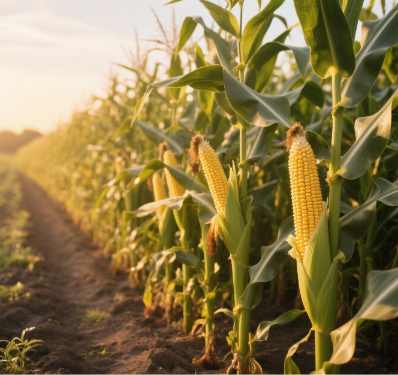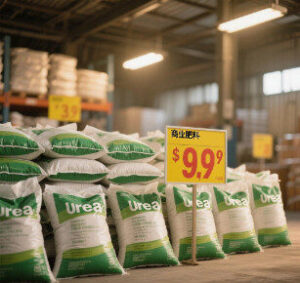In 2023, China experienced an unprecedented surge in corn imports. December alone set a new record with 4.95 million tons imported, marking a staggering 468.9% year-over-year increase. This record for a single month not only reflected a sharp spike in demand, but also marked a significant shift in China’s agricultural import strategy. The annual import volume reached 27.13 million tons, which is a 31.6% increase from the previous year. This figure substantially exceeds the 7.2 million-ton import quota and highlights the country’s reliance on global markets to meet domestic needs. Since 2020, China’s corn imports have more than doubled, growing from 11.3 million tons to 27.13 million tons, indicating a persistent upward trajectory.
Key Import Sources: A Dominant Duo and Diversification Efforts
Brazil and the United States remain the primary suppliers of China’s corn imports, accounting for 73.54% of the total volume together. Brazil emerged as the leading source in 2023, supplying 12.81 million tons (47.21% of total imports) and surpassing the U.S. by a significant margin. However, the U.S. maintained its position as a key supplier, contributing 7.14 million tons (26.34%). Brazil’s share increased by 8.3% compared to 2022, reflecting China’s deliberate shift away from the U.S. to reduce geopolitical dependencies. Despite geopolitical challenges, Ukraine remained a significant player, supplying 5.52 million tons (20.34%) of corn, though its share decreased by 4.6% from the previous year due to supply chain disruptions. Russia and Kazakhstan accounted for 1.23 million tons (4.54%) and 0.42 million tons (1.55%), respectively, offering the cheapest corn prices at 1.08 and 1.98 yuan per kilo. This indicates China’s exploration of cost-effective alternatives to traditional suppliers. U.S. corn averaged 2.56 yuan per kilogram, which was 18% higher than Brazilian corn (2.20 yuan per kilogram) and 29% more expensive than Russian corn. This price difference significantly influenced import decisions.
Dissecting the Drivers: Why Imports Despite High Domestic Production?
China is the world’s largest corn grower by cultivated area (approximately 43 million hectares in 2023) and the second-largest producer after the United States, yielding 277 million tons in 2023. Therefore, China’s reliance on imports may seem counterintuitive. However, a closer examination reveals multifaceted reasons why.
1. Soaring Domestic Demand: A Demand-Supply Gap
China’s demand for corn has outpaced production growth. The pork and poultry industries, in particular, drove feed demand to a record 185 million tons in 2023, which is a 12% increase from 2022. The food processing sector consumed an additional 30 million tons, while biofuel production demanded 15 million tons. This pushed total domestic consumption to 230 million tons in 2023, a 9.5% increase from 2022. Although domestic production reached 277 million tons, it left a 53 million-ton gap that necessitated imports.
2. Cost and Price Advantages: Economics over Geography
Imported corn offers significant cost advantages. Brazilian corn benefited from lower transportation costs via ocean routes and subsidies. Meanwhile, U.S. corn remained competitive despite higher prices due to advanced farming technologies and economies of scale. Chinese farmers, who were facing rising labor, fertilizer, and land rental costs, struggled to match these prices. Domestic corn prices averaged 2.70 yuan/kilo in 2023, which was 22% higher than Brazilian imports. This difference incentivized businesses to prioritize foreign supplies.
3. Food Security Strategy: Building Resilience Through Diversification
China’s food security strategy prioritizes import diversification. Since 2020, China has reduced its reliance on the U.S. for imports, decreasing from 40% to 26.34% between 2020 and 2023. During this period, China increased its imports from Brazil, rising from 35% to 47.21%. This shift aligns with China’s “Dual Circulation” policy, which balances domestic and international supply chains. Grain reserves, including 60 million tons of corn as of 2023, are further strengthened by imports to withstand potential shocks such as droughts or trade tensions.
4. Industrial Needs: Specialized Varieties and Quality Requirements
The biofuel industry requires high-starch corn varieties, accounting for 6.5% of total imports in 2023 (1.76 million tons). Similarly, food processors seek low-moisture corn for a stable shelf life; this is a segment where domestic supply often falls short. Ukraine, Brazil, and the U.S. supply these specialized varieties, filling critical gaps in China’s industrial chain.
5. Resource and Environmental Limits: A Constraint on Expansion
China’s arable land per capita (0.08 hectares) is less than half the global average. This issue is further compounded by soil degradation in 30% of corn-growing regions and water scarcity in northern provinces. To preserve land for rice and wheat, staples of food security, imports act as a “virtual land” strategy, effectively outsourcing production to countries with higher resource availability. Every ton of imported corn saves approximately 0.3 hectares of domestic land and 1,200 cubic meters of water.
6. Trade and Diplomatic Policies: Strategic Alliances and Market Dynamics
China’s pivot to Brazil is in line with its diplomatic efforts to strengthen ties in South America. The 2022 signing of the China-Brazil Agricultural Cooperation Agreement expedited corn exports while the U.S. faced import tariffs and geopolitical tensions, which pushed prices higher. Russia and Kazakhstan’s growing role in supplying goods also reflects China’s “Belt and Road” initiative, which strengthens economic ties with Central Asian nations.
Implications and Future Outlook
China’s surge in corn imports is a complex interplay of economic necessity, food security imperatives, and geopolitical maneuvering. Although strategic, reliance on imports poses risks, such as price volatility in global markets (e.g., due to Brazil’s droughts or U.S. export policies) and supply chain vulnerabilities (e.g., due to Ukraine’s geopolitical conflicts), which could disrupt supplies. To mitigate these risks, China is investing in domestic productivity and launching the “Corn and Soybean Capacity Improvement Plan” in 2024. This plan aims to increase yields by 10% by 2030. Additionally, advancements in biotechnology, such as the development of drought-resistant corn varieties, and pilot projects in vertical farming, aim to increase self-sufficiency. However, given the projected 5% annual growth in demand from the livestock and biofuel sectors, imports will likely remain a cornerstone of China’s corn strategy, necessitating ongoing diversification and resilience-building measures.
In summary:
China’s surge in corn imports in 2023 was a calculated strategy to bridge demand-supply gaps, leverage global cost advantages, and strengthen food security. Through supplier diversification, hedging against resource constraints, and aligning imports with diplomatic objectives, China exhibits a nuanced approach to balancing short-term economic efficiency with long-term sustainability. As global markets evolve and domestic production adapts, China’s corn import landscape will continue to reflect its shifting priorities regarding agriculture, trade, and geopolitics.
Key Data Highlights (2023):
Total imports: 27.13 million tons (up 31.6% year over year)
Brazil’s share: 47.21% (up 8.3% vs. 2022).
U.S. share: 26.34% (down 5.2% from 2022)
Ukraine: 20.34% (down 4.6% from 2022)
Price differential: U.S.: 2.56 yuan/kilo vs. Russia: 2.16 yuan/kilo
Demand Segments: Feed (68%), food processing (11%), biofuel (6.5%)
Virtual land saved: 8.14 million hectares through imports
Data Sources: GACC, USDA Foreign Agricultural Service, FAOSTAT, and China National Grain and Oils Information Center.









